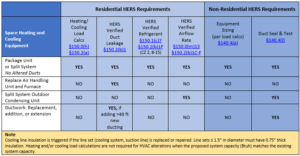PG&E’s Energy Savings Assistance Common Area Measures (ESA CAM) program incentivizes up to 100% of upgrade costs for heating, ventilation, and air conditioning (HVAC) equipment installed at eligible low-income multifamily properties. HVAC systems are often the highest energy-using component of any building due to consistent daily use and are essential to occupant health, safety and comfort. Particularly in regions with high cooling demand, like the San Joaquin Valley, or properties that house sensitive populations, such as senior or medical baseline facilities that require higher standards for temperature control, indoor air quality and ventilation. This blog will cover the HVAC compliance requirements and how it relates to the ESA CAM verification process.
When a HVAC system is altered or replaced, California’s Title 24 Energy Code is triggered and requires new installations to meet state or local efficiency standards, in addition to requiring post-completion field verification and/or testing by a third-party Home Energy Rating System (HERS) Rater. HERS raters provide the necessary compliance services to ensure, and report, that HVAC systems are installed according to code requirements. Since HVAC systems are high energy users and require diligence to install correctly, the HERS compliance process requires post-installation testing unlike most other ESA CAM measures. HERS verification for HVAC measures is also an area that many ESA CAM project teams have required assistance with, such as confirming which compliance forms are required, guidance on proper form completion, and even repeat HERS testing failures. In this article we review when a HERS verification is triggered, summarize required compliance forms, and project other HERS resources to help every project complete this important step successfully.
TIP: ESA CAM recommends project teams engage a HERS rater early to help navigate the compliance process, prepare applicable compliance forms, schedule testing to ensure systems meet minimum state code or local jurisdiction efficiency requirements. To locate a HERS rater near you visit either California Energy Commission-approved HERS Provider websites: CalCERTS or CHEERS.
Title 24 HERS Triggers
Title 24 is divided into “Residential Single Family and Low-Rise Multifamily” and “Nonresidential/High-Rise Multifamily/Hotel and Motel Buildings” code standards, which means ESA CAM HVAC installations can fall into either category. High-rise buildings (four stories or more) are classified as non-residential, while typically, low-rise multifamily buildings (less than four stories) adhere to residential requirements. However, there are instances where stand-alone common area buildings (e.g., leasing offices, community rooms, etc.) fall under non-residential requirements. Another reason why engaging a HERS compliance expert early is important.
The table below – repurposed from Energy Code Ace – shows a list of common ESA CAM space heating and conditioning equipment (or “measures”) that trigger HERS compliance for residential and non-residential building types.

This table is adapted from Energy Code Ace’s 2019 Trigger Sheets. See energycodeace.com or 2019 Building Energy Efficiency Standards – Title 24 for more information
Notice that HERS verified duct leakage testing will be required if the existing system has a ducted air distribution. Often existing ductwork is not adequately sealed (or “leaky”) releasing valuable conditioned air into attics or to intended spaces. Duct leakage testing evaluates the distribution of air to confirm that sealing or insulation allows the HVAC system to operate in compliance with minimum code standards. Plan for this test and possible corrections if needed. ESA CAM recommends that, as part of the work scope the contractor inspect the ductwork for disconnections and sealing to prevent leakage. Common locations where sealing should be inspected are registers, grilles, boots, air handler, coil, plenums, duct material. By planning ahead and focusing on quality and compliance, installations can pass duct leakage testing the first time.
It is important to note that HERS verification is different than building commissioning services provided by the installation contractor. If a new inspection is unable to pass HERS testing it is the responsibility of the contractor to make adjustments or repairs to the installation until it functions according to manufacturer installation standards and can be HERS verified. HERS Raters are also not permitted to be employed by the builder/installation contractor of the project being inspected in order to ensure there is no conflict of interest (another Title 24 code requirement). For more information about HERS review Energy Code Ace’s 2019 Energy Code Fact Sheet.
How does this relate to the ESA CAM process?
Every ESA CAM project will need to submit proof of compliance if HERS is triggered. This proof of compliance is required both by local jurisdictions to close permits and also as part of ESA CAM’s verification process before incentive payments can be released. All triggered HVAC measures will need to show passing HERS compliance forms, confirmation of submittal to the appropriate agencies, and proof of closed permits from the local jurisdiction.
For residential and low-rise multifamily spaces, there are three compliance forms for HVAC systems:
- Residential Certificate of Compliance (CF1R): The energy design of a building; this form determines which tests or verifications are required.
- Residential Certificate of Installation (CF2R): Confirms the installed unit meets energy efficiency and code requirements; typically provided by the installer. Must be submitted to HERS provider online data registry.
- Residential Certificate of Verification (CF3R): HERS verification findings and test results. Must also be submitted to HERS Provider’s online registry.
ESA CAM requires submittal of the CF1R and CF3R as part of the project verification package.
For nonresidential and high-rise multifamily spaces, there are four types of compliance forms for HVAC systems:
- Mechanical – Non-Residential Certificate of Compliance (NRCC-MCH-E): The energy design of a building; this form determines which tests or verifications are required.
- Non-Residential Certificate of Installation (NRCI -MCH-01): Confirms the installed unit meets energy efficiency and code requirements; typically provided by the installer. Must be submitted to HERS Provider’s online registry.
- Non-Residential Certificate of Acceptance (NRCA-MCH-04): Functional testing and construction inspection results.
- Non-Residential Certificate of Verification (NRCV-MCH-04): HERS verification findings and test results. Must also be submitted to HERS Provider’s online registry.
ESA CAM requires submittal of the Certificate of Compliance (NRCC-MCH-E) and Certificate of Verification (NRCV-MCH-04) as part of the project verification package.
ESA CAM staff will work with project teams to ensure they understand basic HERS compliance requirements and have access to resources such as Energy Code Ace. For any additional questions, please reach out to your ESA CAM case manager or either HERS Provider to ensure systems are installed and operate according to Title 24 standards.
For more information on the ESA CAM Verification Package, click here.



